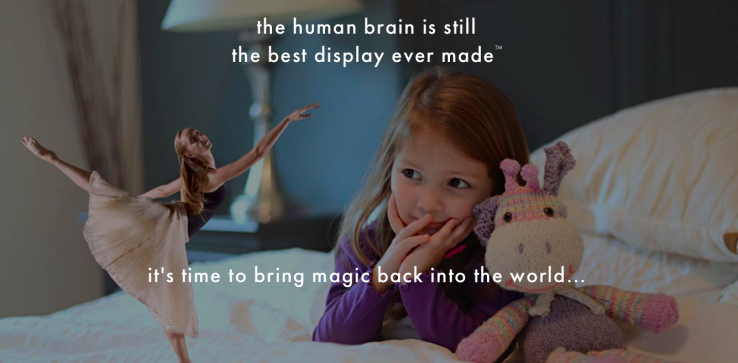Fast Company: Magic Leap “oh, you know, replicates the visual perception system of the human brain as a go-anywhere, mobile computing platform.”
Right now (as always) the internet is buzzing about a potentially huge but definitely vague announcement. Florida-based startup Magic Leap is in the final stages of developing a technology that is being called a game changer for augmented reality. They have secured $542m in venture capital funding from a long list of investors that TechCrunch reports as including Andreessen Horowitz, Qualcomm, and the biggest of them all, Google Inc.
Magic Leap has been exceptionally vague about what their technology actually is or does, and we can assume this is intentional–a case of the company keeping a tight lid on things in order to stir up excitement and retain mystery. Founder and CEO Rony Abovitz is quoted as saying that Magic Leap is not making virtual, augmented, or digital reality technology in the way we’ve come to think of it, but something entirely new: “We are transcending all three, and will revolutionize the way people communicate, purchase, learn, share and play.”
Want to know more? Here’s a quick primer culled from stories by the big guns in the technology world, and ideas about how this technology might change the way you do your job. Just be very aware that these statements, though smart and educated, are still conjecture based on close-reading.
- MIT Technology Review dug through Magic Leap’s patent applications, and was able to determine the form the technology will likely take. Surprise! It’s another wearable display, this time powered by a computer you wear on your hip.
However, it likely won’t work the same way existing wearable displays like the Oculus Rift do. Where the Rift is essentially a fancy stereoscope that shows each eye a different 2D image in order to simulate a 3D space, the Tech Review suggests that the Magic Leap will be much more advanced. They say it will probably use “displays that can create the same kind of 3D patterns of light rays, known as ‘light fields’ that our eyes take in from the real objects around us.”
These displays could comprised of (and I couldn’t make this up if I tried) multiple layers of tiny mirrors formed from a magnetic liquid. This liquid “would allow the mirrors to be reprogrammed using a magnetic field to rapidly display points at different depths fast enough to fool the eye, like the frames of an animation.”
The upshot: Magic Leap could enable you to focus on different parts of a virtual 3D object the way you would focus on a physical object. It would make your virtual or augmented reality simulations look like they exist in the real world.
- TechCrunch managed to glean some more information about the hardware by looking at a bevy of job listings recently posted on the Magic Leap site.
“Specifically,” they write, “there are a number of job descriptions relating to optical, lens and laser technology, including eye tracking, as well as positions in computer vision and machine learning.” They say this means Magic Leap will likely project images “directly onto a user’s retina.” (!)
As for the software platform, they say it is almost certainly based on Google’s Android and will render using the Unity3D gaming engine.
- Fast Company talked to a few sources (both official and unofficial) to provide some ideas about Magic Leap’s timeline and business plan.
According to Magic Leap CEO Rony Abovitz, the technology will be released “very near term.”
Magic Leap sees the tech as being useful to a number of fields. Abovitz is quoted as saying that he’s interested in everything from “new spreadsheets to Pacific Rim-type things.” Later adding, “there’s a lot more than what it can do in entertainment.” (And let’s hope his plans extend beyond spreadsheets.)
Thomas Tull, CEO of Legendary Entertainment (which produced the Dark Knight trilogy), told Fast Company that Magic Leap’s technology is “so badass you can’t believe it.” He added that “it’s one of the few things I’ve ever experienced in my life where I came out and said, ‘This changes everything. This is a marker of the future.’ “
What Could it Do for You?
All the rapturous praise the technology has already received could turn out to be hype. However, even if it’s not the biggest thing since the lightbulb, Magic Leap’s interface could still end up being very useful in our industry.
We’ve already seen what Google Glass can do–imagine if that clunky and borderline unusable technology were more advanced. It could operate as a new way to deliver spatial information to work crews when they’re on site, for instance. Or, if coupled with some of the smaller 3D sensors coming on the market, it could feed information back to project managers offsite.
More importantly, such advanced augmented reality could give you a way to offer better, simpler deliverables to your customers. As Jonathan Coco, advanced measurements and modeling manager at Forte and Tablada told me, “Maybe in our industry it can help us find better ways to let others navigate the 3D spaces that we get to play in all day,” by making the viewer an active participant moving through a realistic feeling space. If a video game engine can help a space feel real to a viewer, imagine what this kind of augmented reality could do. Coco added, “I can’t wait until the day when we can capture a complex environment, resulting in massively complex data, and then deliver it to the end user in a form that could be even simpler than a video game.” With Magic Leap, maybe that day isn’t as far as off as we think.
For now, though, all we can do is speculate and comb the net for more info. That or loop Magic Leap’s crazy .gif of a tiny floating elephant.






